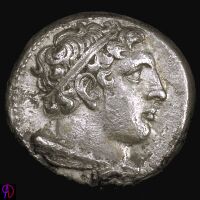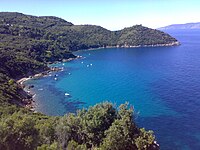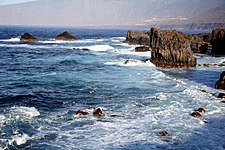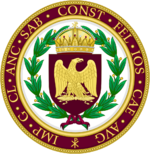Latium
Latin Empire Imperium Latinum (Latin) | |
|---|---|
| Motto: In hoc signo vinces ("In this sign you will conquer") | |
| Anthem: Latio noster aeterne Our Eternal Latium | |
| Imperial Seal: | |
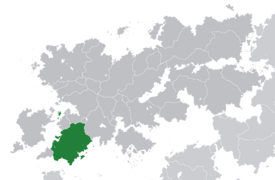 Location of Latium (dark green) – in Belisaria (dark grey) | |
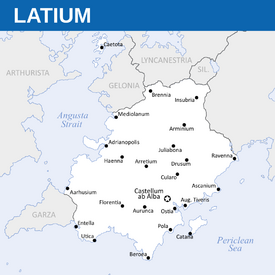 Political Map of Latium | |
| Capital and largest city | Castellum ab Alba |
| Official language | Latin |
| Ethnic groups (2019) |
|
| Religion | State religion: Imperial Church (Catholicism) Other recognized: Protestantism (Reformed, Episcopalian, Union Reformed) Aletheic Church, Judaism, Azdarin, Irreligion |
| Demonym(s) | Latin |
| Government | Unitary semi-parliamentary executive monarchy |
| Diana I Anicia | |
| Jacobus VI Claudius | |
| Constantine XX Claudius | |
| Florian Claudius | |
| Alexander Pompilius | |
| Legislature | Senate |
| Formation | |
• Founding of Castellum | 821 BC |
• Latin Kingdom | 290 BC |
• Proclamation of Empire | 3 August 127 AD |
| 19 November 1866 | |
• Acts of Constitutional Reform | 9 June 1954 |
| Area | |
• | 584,850 km2 (225,810 sq mi) (nth) |
| Population | |
• 2019 estimate | 87,216,912 |
• 2017 census | 86,832,912 |
• Density | 117.69/km2 (304.8/sq mi) |
| GDP (PPP) | 2018 estimate |
• Total | $4.021 trillion |
• Per capita | $46,109 |
| GDP (nominal) | 2018 estimate |
• Total | $3.971 trillion (3rd) |
• Per capita | $45,539 (4th) |
| HDI | 0.873 very high |
| Currency | Solidus ($) (LAS) |
| Date format | dd/mm/yyyy (AD) |
| Driving side | left |
| Calling code | +40 |
| ISO 3166 code | LA |
| Internet TLD | .il/.la |
Latium, also know as the Latin Empire (Imperium Latinum) or less commonly as the Empire of the Latins, is a sovereign state located in southern Belisaria sharing borders with Gelonia, Garza, Lyncanestria, and a maritime border with Arthurista. It is located in southwestern Belisaria, bordering the Angusta Sea to the west, Periclean Ocean to the east and south, and the Salacian Ocean to the southwest, placing Latium at a key crossroads of international trade.
Latium is a unitary parliamentary executive monarchy. The current monarch is Emperor Constantine XX, who has reigned since 2016. Latium's capital and largest city is Castellum, with an urban population of 9.5 million. Other major urban areas are Adrianople, Ascanium, and Utica.
Since the classical period, ancient Aradians, and Hellenes established settlements in southern and eastern Latium respectively, with Latinic tribes spread throughout the rest of the peninsula. A Latinic tribe known as the Albans would establish the Alban Kingdom, later merging with another Latinic tribe centered around Castellum to create the ancient Latin Republic. Eventually, the Latin Empire expanded to encompass nearly the entirety of the Periclean coast, including the modern-day territories of Audonia, Garima, southern Ottonia and coastal northern Scipia, resulting in it emerging as a dominant cultural, political, and religious center.
During the middle ages, the ancient Latin Empire collapsed, resulting in widespread turmoil in Latium, but the Latin Crown persisted, living on in Ascanium, and by the 12 century growing to be recognized as the main successor to the Latin Empire, over its chief rival in Adrianople. These two competing crowns often battled one another, often clashing with the Audonic-states of the Holy Audonian Empire to the north. By the 14th century, Latins had expanded once again, this time across the Salacian Ocean, establishing colonies in Norumbia, modern-day Belfras. The 14th through 18th centuries saw Latium expand towards its modern-day borders, after clashes with Audonic neighbors in modern-day Lyncanestria and Lihnidos. By the 19th century, Latium experienced rapid industrialization, and despite its economic and geopolitical gains, suffered the rise of socialism in the 1930s, ultimately resulting in the Social War in 1945. Following the conclusion of the war in 1947, Latium experienced an economic boom and the introduction of modernizing reforms.
Today, Latium has the Xth largest economy in the world. It maintains an advanced economy, and is home to high human development and life expectancy. The country plays a major role in regional and global economic, military, cultural, political, and diplomatic affairs. It is a founding and leading member of the Forum of Nations, the Civitas, and the Trans-Periclean Free Trade Area, as well as a participating member of the Joint Space Agency.
Etymology
The first mentions of the name Latium was first arise from the initial unification of the various Latin tribes in the area of Castellum, which was occasionally referred to as Alba. The term Latium, originally, only referred to this area near the Eridanus River, though later expanded to be used as a term for the entirety of Latin controlled territory from the 5th century onward. Latium is believed to have been derived from the word "latus", meaning "wide" or "flat land". Similarly, the demonym "Latin", and the Latin tribes of the region, are believed to mean "men of the plain".
History
Latin culture traditionally traces its roots back to ancient Latinic tribes of southwestern Belisaria. Historically, the area had been inhabited by a variety of different tribal groups, from minor Celtic tribes in the northwest and coastal regions, minor Rhegedi tribes along the eastern coasts, and Latin tribes spread throughout the rest of Latium. Greek cities had originally been founded as early as 911 BC in modern day Imbros, on the western coast of Latium. Modern Latins primarily descend from the ancient city of Castellum and its surrounding area consist of Latium's major ethnic group; however, Hellenes remain a sizable minority and make up nearly 4% of the population.
The ancient peoples of Latium – such as the Pelasgians, Aimones, Aeolians, the Eleni and the Rasinai which inhabited northern modern Latium, and many others – were other proto-Latinic peoples; the main historic peoples of proto-Latinic heritage include the Latinii, Iolei, Samnii, Sabini, Camerii, and Volsinii.
Between the 15th and the 11th century BC Greeks traders established contacts with the many non-Hellenic early ancient peoples and in the 10th and 9th centuries BC, Greek colonies were established all along the coasts of modern day Latium, eventually making inroads into the interior. These Greek settlers would first come into contact with Castellum near the 9th century BC, which at the time was a small agricultural community. However, recent excavations outside of modern day Ascanium create a theory that there were far more ancient cities that were much older than ancient Castellum.
Classical era
Castellum, founded near the mouth of the Frusina River, was conventionally founded in the 9th century BC, and was ruled by a dynasty of kings from its founding until the 4th century BC, when it incorporated a form of oligarchic rule, while the role of king was slowly diminished. Tradition claims that the city was founded by Apollo, and that all kings were descended from him. Around the 6th century BC, Latins inhabiting Castellum often clashed with neighboring settlements, most commonly Alba and Heliopolis – a major Hellenic settlement at the time. By the 3rd century BC, Castellum incorporated much of eastern Latium. During the reign of Gaius Caesar in near the end of the 2rd century, the monarchy regained many of its prerogatives, and saw a decline in the oligarchic system in the Senate.
Over the course of its history, Castellum and its surrounding area was often referred to as Latium, from which the empire and modern nation take its name. By the 1st century, the Latin people of Castellum and Alba proclaimed King Valentinian to be "Imperator Latini" (Latin Emperor or more archaically, Latin commander), to denote his role as the leader of all Latin tribes, peoples, and cities, as well as Castellum and Alba's dominion over much of what is now eastern and central Latium, while reaching as far south as Utica, where it constantly entered hostilities with Aradian settlements.
Imperial era
The Caesarian-Martii dynasty ruled over the fledgling Latin Empire, and throughout this period, the Latin Empire, which was increasingly called Latium or Latia, faced repeated attacks from the remaining Aradian city-states that held out on the southern coast near Boroea and Orola. The Aradian city-states would persist until the 2nd century BC when the Aradians were finally pushed off of Belisaria and only retained their Scipian holdings; however, those too would eventually fall to Latium at the invasion of Master of Offices Felix Claudius, who finally ended the long and storied history of the once mightly Aradian civilization, reducing it to a Imperial province in 150 BC.
The entrance into Scipia via the wars with Aradia served as a springboard for future conquests of northern Scipia and Lihnidos, which was incorporated into the Latin Empire by the 1st century AD. Future conquests saw the empire expand to encompass the entire Periclean Sea, stretching from modern day Sydalon and northern Yisrael in West Scipia to Dzhuvenestan in the east and north into what is now Ottonia.
The early Imperial era was marked by continued grown of the aforementioned conquests of neighboring communities and non-Latin kingdoms or cities. However, the era was marked with tremendous cultural and religious upheaval. In this time, from the 1st century AD until the 4th century, Latium had been dominated by the pagan cults of Apollo as the god of light, fire and life and his chief adversary Februus as the god of darkness and death. The Christian faith was first introduced during the late 1st century AD. Initially, the faith was limited to small folk and lowborn subjects of the empire. Members of the faith were sporadically persecuted by the Latin emperors, and often blamed for poor harvests, and other catastrophes. The worst such event was following the fire of Castellum which consumed nearly half of the city, when Emperor Lucius ordered the christian population of the city to be killed. While some were able to flee and escape death, many were executed.
The faith spread quickly among the masses, and later gained Imperial support from the Emperor Ahenobarbus I during his youth. Emperor Ahenobarbus' conversion was prompted by a a vision one night and was told that "in Jesus' name [he] will conquer" and that Latium would truly fulfill its destiny. Ahenobarbus challenged his uncle, Emperor Celsus and assumed the throne. Sarpeticism became widely accepted following Celsus' defeat. It was later proclaimed the official state religion in 151 AD. The teachings of the Bishop of Alba became widely accepted among Latins and the imperial family, and became the official state religion in 372 by edict of Emperor Iovanius I.
| This article is part of a series on the |
| Politics of Latium |
|---|
 |
Middle Ages
Colonial empire
Modern Age: Reform and Social War
Contemporary history
Geography
Latium is located on the continent of Belisaria. To the north, Latium borders Gelonia and Lyncanestria, and Garza to the south. To the west, Latium shares a maritime border with Arthurista. It is located at the southern tip of Belisaria, and holds a key location at the Aradian Straits between Belisaria and Scipia, where the Salacian Ocean meets the Periclean Sea. Nearly half of Latium consists of mountains or hills, with mountains being located in the Hellenic counties of the east, near the Lyncanestrian border. Although the country's core is located primarily on continental Belisaria, Latium controls a number of islands off its coast, including the Periclean island of Imbros to its east, the Aveli Islands located 50? miles off the coast of Sydalon in the Aradian Straits, Perateia in the eastern Periclean-Ozeros region, and a chain of islands in the Southern Salacian Ocean.
Biodiversity
Latium has a high level of biodiversity due to its location between the Periclean and the Salacian and between Belisaria and Scipia. Latin fauna includes some 3000 species, including Latin wolves, Gelonian red deer, Appennina brown bear, Imbrosian seal, a number of frogs and other amphibians, etc. Flora of Latium matches that of other nations located in the Periclean climate regions, and has nearly 6,000 types of plant species.
Climate
The coastal areas along most of the south generally fit the Periclean climate stereotype (Köppen climate classification Csa). Conditions on north coast, along the Periclean coast can be very different from the interior's higher ground and valleys, particularly during the winter months when the higher altitudes tend to be cold, wet, and even snowy. The coastal regions have mild winters and warm and generally dry summers, although lowland valleys can be quite hot in summer. Interior areas largely consist of climates ranging from humid subtropical to humid continental. However, summers are typically hot and dry, with more mild and wet throughout Latium.
Landscape of central Latium near Cularo
Vineyards located in western Latium near Adrianople
Politics
The modern Latin state traces its legitimacy to the ancient Latin Empire and first emperors of Latium. Many of Latium's current government structures are derived from the ancient constructs, however have been reformed on occasion throughout history. The most recent series of reforms were introduced during the reign of Empress Diana I Anicia and Emperor Leo X Claudius throughout the 1950s and 1960s.
Latium is a unitary state, where the central imperial government is supreme and the many administrative divisions are afforded only the limited powers delegated to them by the central government. The central government refers to the Emperor, and civil court officials and key military officers. The degree of devolved powers given to a diocese are largely allocated on a case-by-case basis. These devolved powers are subject to Imperial assent that generally require renewal after any number of years.
Monarch
The position of the monarch traces its beginnings to the ancient kings and later emperors of Latium. These ancient rulers initially gained their powers from their armies and later as simply being the leader of the Castellum and Alba.
Today, the Monarchy is classified as an executive constitutional monarchy, afforded the monarch wide reaching control of the government. The Monarch serves as the chief executive, sharing many of the same powers as a president in a presidential system or semi-presidential system. He simultaniously holds the position of Princeps Senatus or First man of the Senate, and enables him to serve as the nation's chief legislator. Through this role, Monarch holds the power to directly propose legislation and laws. Additionally, the Monarch possesses the ability to direct much of the executive Imperial Court through executive edicts that are grounded on constitutionally granted executive power. An expansive court and bureaucracy exists around the Emperor, who is supported by numerous administrative officials. Chief among these officials is the Master of Offices, who serves as a de facto head of government.
The monarch represents Latium abroad and in international relations, giving the monarch the ability to direct foreign relations. The emperor is also the commander-in-chief of the armed forces, and is the only individual that is able to declare war. However, any declaration of war requires Senatorial approval and the Senate may even petition the Emperor for a declaration – these war powers primarily exist due to constitutional convention. The monarch also must provide imperial assent in order for Acts of the Senate to be signed into law. While in some constitutional monarchies the Crown in Parliament is nearly a rubber stamp, it is not so in Latium, where the Monarch retains actual, significant political authority and activity in the legislative process.
Senate
The Senate is one of the oldest organs of the Latin government, dating back to the 8th century BC as the Alban council of elders. The first recorded written records of the Senate are dated to the 6th century BC. The Monarch is the head of senate by virtue of being Princeps Senatus, literally "first man of the senate." However, following numerous reforms in both the 1860s and 1950s, the senate is the unicameral legislature of Latium. The Praeses serves as the First Praetor on the Collegium Primicerium, and as the presiding officer of the Senate, the latter of which it derives much of its constitutional authority. In practice, the praeses senatus responsible to both the monarch and the senate, and must maintain the confidence of each to retain office. However, Senate rules allow for the Senate to expell its members by a super-majority vote, in theory allowing for the praeses senatus to be responsible to the Senate.
Today the Senate consists of 794 senators which are appointed or elected from a single, nation-wide faction list. The Senate holds authority over financial and budgetary matters. Legislation is enacted by the Princeps Senatus whereby the Senate and praeses senatus may pass legislation within the legislature, but also provides the emperor an integral role in signing, aiding in drafting and negotiating, and often times proposing legislation. While the emperor may propose new laws, longstanding convention allows the senate the important right of co-operation, where new laws are discussed between the emperor, his council, and the senate before approved by the emperor. This tradition has existed since the 7th century, though fell out of use from the 12th to 18th centuries when it was restored.
The Senate Building, often referred to as Curia Claudia or more irregularly, Palatium Forum, is located near the Forum in Castellum ab Alba.
Law and criminal justice
Law in Latium traces it's roots to the early royal, republican and imperial era in Latin history. For most of it's early history, laws were a large conglomeration of Senate acts, royal and imperial edicts, as well as court rulings, until it was complied and reformed into the Corpus Juris Civilis in AD 928. While Latium utilizes an uncodified constitution, it relies heavily on statutory law in the form of the Codes of Law, which is updated annually. Laws in the Body of Law reach back thousands of years, some of which are still valid unless more recent law contradicts it. However, most laws from before 1860 are no longer valid following the Acts of Constitutional Reform, which aimed to modernize the government and legal system by officially codifying structure of the government. These edicts serve as a basis for the constitution of Latium.
Administrative Divisions
Latium has a number of administrative divisions, each with varying levels of authority or non-authority. Until recently, there was no uniform standard throughout the nation for administrative divisions and which held authority over another, leaving some counties and provinces often at odds. The broadest forum of division would be the Augustal Prefecture, of which there are four: the Augustal Prefecture of the East, Augustal Prefecture of the West, Augustal Prefecture of the Straits, and Augustal Prefecture Ultramare. These divisions, while sitting as a top level division, serve little functional purpose and hold minimal administrative capacity other than regional grouping or military use.
The first administrative division with government functions is the diocese. Each prefecture contains a number of dioceses. The Diocese of Alba is coterminous with the province of Alba, and is one of the few dioceses that features a consultative assembly. Below diocese are province level divisions, which has historically held the most authority. As of 2019, there are a total of 109 provinces. While no one province is equal to another, typically a provincial government consists of an appointed propraetor who serves the province on behalf of the Emperor, acting in concert with a provincial council.
Provincial authorities most often include powers over: arts planning, parks, tourism, archives, industrial assistance, and police or fire safety. However, police can be and is often delegated to large cities within a given province, or the diocese level, for example Adrianople
Arces imperialis
The arces imperialis, or imperial strongholds, are a series of territories located outside of mainland Latium, or what is considered Latium proper. This term has been utilized since the late 18th century and the cessation of Terresina to Latium. Most of these territories are directly administered by the central government, with the exception of Lampeda and Sasora, which have varying levels of devolved administration. Two strongholds are administered under a single diocese, Scheria and Terrasina, within the Diocese of Scipia Periclea, while Panarea and Tiberia are within the Diocese of Volsinia.
| Name | Administrative status | Capital |
|---|---|---|
| Template:Country data Lampeda | Caesarian province | Odia |
| Template:Country data Panarea | Caesarian province | Cosa |
| Caesarian province | Caetot | |
| File:AU-Scheria-flag.svg Scheria | Caesarian province | Aemona |
| Template:Country data Tiberia | Caesarian province | Theodorias |
| Template:Country data Terrasina | Municipium | Veteropolis |
Foreign Relations
Latium maintains diplomatic missions with nearly all nations of the world through embassies. Latium is a member of numerous international organizations, including the Forum of Nations, the Civitas, the Catholic Cooperation Council, and P5, of which the three former maintain main secretariat and headquarters in Castellum ab Alba.
Historically, Latin foreign policy has followed strategy of divide and conquer, fighting numerous wars to lead to the dissolution of the Holy Audonian Empire and prevent unification efforts of early modern nations such as Lyncanestria and Ghant. Additionally, Latium has also supported Catholic nations against foreign action, notably in Sydalon. As republican revolutions began to rise in the 19th and 20th centuries, Latium supported monarchist states. Today, however, Latium maintains warm relations and trade ties to numerous republics, such as Drevstran.
Alanahr, Belfras, Garza, and Lihnidos are considered Latium's chief allies; however, Latium maintains strong relations with nearly all members of the Citivas. Latium's relationship with Drevstran is widely considered key in its control in the eastern Periclean and eastern Belisaria. Due to the personal union and shared monarch, Latium and Perateia maintain an especially close relationship and ties in foreign affairs. This relationship has led to complications in the Eastern Periclean and various disputes with Vardana. Control of the maritime route connecting the Periclean and Ozeros Seas has lead to the somewhat controversial Eastern Policy, which has existed in various forms since it was first instituted in 1839, and dictates control and passage through the Perseid Straits. Another integral foreign policy of Latium is the Periclean Policy, which governs outside intervention, or military presence, in Belisaria and particularly the Periclean Basin.
Military
The Latin Army, Navy, Air and Space Force, Scholarian Guard and the Praetorian Guard – a quasi branch of the military – collectively form the Latin Armed Forces, under the command of the Monarch as commander-in-chief. Military service is entirely voluntary and has been since 1988.
In 2016, the Latin military had 340,377 personnel on active duty. There are also nearly 100,000 members of the Scholarian Guard, who act as a national gendarmerie. There is no estimate as to whether Latium has access to nuclear weapons. Latium's chief international intelligence agency is the SAI; while it's chief domestic intelligence agency is the Frumentarii. Both are officially a branch of the Praetorian Guard, though in the modern era each is nearly independent of the Guard. Total defense spending amounts to 2.94% of national GDP.
Elections
There are four types of elections in Latium: senatorial elections, elections to devolved parliaments and assemblies, elections to the provincial commissions and local council elections. Elections are held on election day, which is conventionally a Tuesday or Thursday. Senatorial elections do not have a fixed date, though recent convention sees elections take place roughly every five years – however the Emperor may call for early elections. Generally, provincial and local elections take place every five years.
Elections are administered locally: in each lower-tier local authority, the actual polling procedure is run by the appointed Imperial Electoral Commission officer or Returning Officer, with the compiling and maintenance of the electoral roll by the Electoral Registration Officer. The Imperial Electoral Commission sets standards for and issues guidelines to Returning Officers and Electoral Registration Officers, but is responsible for nationwide electoral administration (such as assisting the Sacred Assembly in registering factions and faction lists, or directing the administration of national referendums).
Economy
Latium has a capitalist mixed economy, is regarded as a highly industrialized nation with a high level of innovation. The Imperial Treasury, led by the Treasury Board, is responsible for the development and execution of government economic and public finance policy. The Bank of Latium (Argentaria Latii), Latium's central bank, is responsible for issuing the nation's currency. Latium combines extensive private enterprise with substantial state enterprise and government intervention. The government retains considerable influence over key segments of infrastructure sectors, with majority ownership of railway, electricity, aircraft, nuclear power and telecommunications. However, some recent governments have worked to privatize or contract out such enterprises. It is regarded as a highly industrialized nation and with high levels of trade and exports. It is a highly developed country, with a high quality of life and level of Human Development Index. The country is well known for its creative and innovative business, a large and competitive agricultural sector, and for its technology, machinery, food, design and fashion industry, with most of these industries being located along the coastal regions of the country. Latium is notable for its exports in expensive luxury items, such as high-priced cars and jewelry, as well as technology.
There has been a growing divide among northern and southern coastal regions, and even among the Hellenic areas of Latium. The central, interior regions of Latium are much more rural and heavily relies upon agriculture. This coastal-internal economic division continues to exist across the borders of the devolved government of Gelonia. Eastern coastal Latium is also largely a rural area, though major population centers exist in Mediolanum, Leonopolis and Ascanium to a lesser extent and is far less populous on average when compared to the rest of the country, due in part to its more mountainous regions in the north and northeast. While Adrianople remains one of the largest city in the country, it is one of the few vibrant cities of the west, with most being situated along the southern coast. The Adrianople Central Stock Exchange (ACSE) is the leading exchange in the country, followed by the Castellum-Southern Stock Exchange.
Agriculture
According to the latest agricultural census in 2012, there were x million farms in Latium, with xx million hectares (over 55% located in southwestern Latium). A vast majority of farms are private, family owned farms, averaging near x hectares. Grain fields take up xx%, olive tree orchards x%, vineyards x%, citrus orchards x%. The remainder is primarily dedicated to pastures and feed grains.
Latium is a leading producer of wine, olive oil, fruits and vegetables. The most famous Latin wines come from the county of Faventia in the northeast, and vineyards in the wine belt (counties of Rhenus, Caieta, Osrhoene, and Collipo) along the Periclean Sea.
Energy
Latium is one of the largest consumers of energy in the world, and is a world leader in nuclear energy. Electicus Latii (EL), the main electricity generation and distribution company in Latium is a major Belisarian energy producer. Nearly 75% of energy in Latium is produced through nuclear power, with roughly 12% being alternative green energy and the remaining through coal or natural gas. Due to the prominence of nuclear energy, Latium is among the smallest carbon dioxide emitters among industrialized countries.
Industry
Tourism
Infrastructure
As of 2016, the the national road network consisted of xxx,xxx km of serviceable roads in Latium, including 8,180 km of motorways such as the Raedavea National Highway system. There is an average of 601 cars per 1000 persons.
The national railway network exists in the form of the government holding company, Ferrovia Phoenix Latiii (FPL). The FPL manages the railway tracks and infrastructure, while it's subsidiary the Ferrovodunum, manages the passenger operations.
Technology
Latium has been home to a strong scientific community that has produced major discoveries in the sciences. Some history on discoveries and scientific history here.
Latium is a leader in civilian nuclear technology, and a nuclear capable country. Through the Cursus Astrum, Latium has heavily cooperated with its Belfrasian counterpart Space Technologies and Aeronautical Research in space exploration, supersonic rocket planes, among others. As such, it became one of the earliest nations to launch a space satellite. In 1968, Latium was a founding member of the Joint Space Agency along with Belfras and Sante Reze. Caelex and Bellona are the leading aerospace companies in the country, with Caelex being among of the largest private spaceflight companies in the world.
A number of research facilities are also present in Latium, including X, Y, and Z. In addition, Latium is a leader in nanotechnology, hosting a research center near Florentia, as well as a particle physics laboratory. It also contributes to X, one of the largest nuclear fusion development efforts in the world.
Since the 1980s, Latium has invested into technology based firms, particularly advanced chip industry, leading to the establishment of IMF to meet domestic demand and additional national security.
Demographics
Largest cities or towns in Latium
Imperial Ministry of Populations (IMS) estimates for 31 July 2017 | |||||||||
|---|---|---|---|---|---|---|---|---|---|
| Rank | Diocese | Pop. | Rank | Diocese | Pop. | ||||
 Castellum ab Alba  Adrianople |
1 | Castellum ab Alba | Alba | 4,936,915 | 11 | Pola | Cameria | 446,574 |  Utica  Ascanium |
| 2 | Adrianople | Aternum | 2,872,021 | 12 | Aurunca | Cameria | 432,067 | ||
| 3 | Utica | Praetutia | 1,850,726 | 13 | Ostia | Cameria | 406,830 | ||
| 4 | Ascanium | Sabinia | 1,530,058 | 14 | Arrentium | Samnium | 394,997 | ||
| 5 | Mediolanum | Picenum | 1,096,773 | 15 | Drusum | Faventia | 375,735 | ||
| 6 | Ravenna | Sabinia | 786,424 | 16 | Bonna | Volsinia | 359,712 | ||
| 7 | Caesena | Praetutia | 696,676 | 17 | Espo | Senonia | 293,518 | ||
| 8 | Antium | Aternum | 521,913 | 18 | Entella | Volsinia | 282,082 | ||
| 9 | Vindobona | Senonia | 499,093 | 19 | Aarhusium | Oenotrium | 242,224 | ||
| 10 | Beroea | Cameria | 482,283 | 20 | Mariana | Imbros | 198,211 | ||
Metropolitan cities and Urban areas
Religion

Christianity is the dominant religion in the Latium, and the Imperial Church has been the official state church since the 4th century.
While the Imperial Church is the official state church and is granted various benefits by this status, freedom of religion for citizens and legal permanent residents is protected through the 1951 Edict of Adrianople and the accompanying 1955 Imperial Church Act. The Pope is considered the spiritual leader of the Church by Latin Catholics and is the highest ranking spiritual leader within Latin borders according to the 1679 Treaty on Liberties and Privileges. Nearly 90% of Christians in Latium are Catholic.
Over 10% of Christians in Latium adhere to a protestant faith. The largest protestant followings in Latium are the United Reformed Communion, Vaudensian Church, the Episcopal Church of Latium, Evangelical-Episcopal Church, and Alban Emendatic Church.
According to the latest census, nearly 6% of all Latins considered themselves irreligious or adhered to no religion. This number rose 5% from the previous census. According to a private poll conducted in 2016, 7 of 10 Latins attend church or some other place of worship on a weekly basis.
Ethnic Groups
Ethnic Latins make up the majority of citizens of Latium at around 93% of the population according to the latest census.
A Latinized-Hellenic population is also located in Latium, commonly referred to as Imbrosians. It is mostly located in the eastern counties of the country, mostly centered on the Imbroaisn isles off the eastern Latin coast in the Periclean Sea. The largest Imbrosian city is Catania.
Latin is the most commonly spoken language in Latium and the only official language of the nation.Gelatin, Imbrosian, and Sasoran are recognized minority languages. As of 2022, Latin remains be the language of schooling, but new laws granted exemptions for schools and universities in some minority language provinces, though Latin remains a required class throughout one's educational career in these areas.
Languages
Latin is most widely spoken language in Latium, and the only language to have official status. There are four regionally recognized minority languages: Latigen, and Sasoran. The most widely studied languages in Latin schools are: Arthuristan, Audonian, Perateian, Rezese, and Tsurushimese.
Health
The Latin government has run a universal healthcare system through the Imperial Health System (Latin: Imperialis Sanitas Systema (ISS)) since 1962. Public healthcare is provided to all Latin permanent residents and is mostly free at the point of need, being paid for by taxation. Latium spends about 8.9% of its gross domestic product on healthcare. Private health insurance is available to those who wish to obtain different treatments; however, in the modern day private insurance in Latium is very rare.
Education
Education in Latium is mandatory from ages five to seventeen and consists of five stages, three of which are compulsory: nursery school (schola seminarium), primary school (schola primaria), middle school (schola medium), secondary school (schola secundaria) and university (universitas). Nursery school is the first stage of schooling, which students attend from ages 3-4; nursery school is not mandatory, though is becoming more common in recent years. Primary education occurs from ages 5 to 11; students are given a basic education in Latin, mathematics, natural sciences, history, geography, social studies, physical education and visual, musical arts, and occasionally Anglic, Audonias, or Hellenic. Middle education occurs from ages 11 to 13. Secondary education occurs from ages 13 to 17. While public, state-run education is available to all children under the age of 18, many can and do send their children to the various charter, private or religious schools. In some remote areas, these private or religious schools are sometimes contracted to admit the locale's students by the government.
College education is not mandatory in Latium, though students may wish to enroll at public, private or standalone graduate universities following their accomplishment of secondary education. The largest public university in the country is the University of Aarhusium located in western Latium. The highest ranked tertiary schools are the University of Haenna, City College of Velia, University of Castellum Iohannes XIII, University of Ascanium, Utica University and Ariminum College. Latium is also home to three service academies: Academia Militaris Olympia, Imperial Air Academy at Acrae, and Imperial Naval College at Pola.
Special provisions are afforded to schools in minority language areas, particularly in Perateia, where classes are taught in either Vardanan or Mysian, alongside Latin.
Culture
Architecture
Literature and theatre
Music
Cinema
The Latin cinema industry began soon after motion pictures were first introduced. The first known Latin film was a minute long clip of a speech delivered by Emperor John XIII in 1903. The first major film companies were founded between 1905 and 1910, including Engrafa, Cinemara, and Cina Latina, primarily based in Castellum, Adrianople, Entella, and Aarhusium. By 1912, Latin films were being sold in other countries. Film media became heavily used for political propaganda purposes during this period as well.
After the Social War, the Latin cinema industry exploded and began to be exported throughout the world. Notable directors include, X, Y, and Z. Today, Engrafa is the largest and most prominent film and television production company in Latium, and among the largest in the world.
Sports
Latium boasts strong national league sports systems and national teams in many sports. The oldest professional sports league in Latium is the Insignis Liga, which was founded in the late 18th century. Lacrosse, along with football and ice hockey, are the most popular team sports in Latium by participation and viewership. Lacrosse primarily operates in the summer, while football and ice hockey compete from late fall to early spring. Most lacrosse and football clubs, and to a lesser extent hockey clubs, are part of the same sporting or athletic societies, and feature more teams than any other sport in Latium. Together the top professional leagues in football (Liga Campiontia), lacrosse (Insignis Liga), and ice hockey (Liga Magna) are considered the Big Three.
Perhaps the most popular sport in Latium today, football was first adopted by Latins in the late 19th century. Latium's men's national football team is one of the most successful in the world, having won the UAFA Cup 7 times (1932, 1942, 1956, 1958, 1962, 1964, 2016), and finished in the top four 15 times. Ascensio Energeia Liga Campiontia is the top flight football league in the country and prominent on the continent of Belisaria; it governed by the Latin Association for Football. In theory, it is feasible for a team to begin in the fourteenth division and eventually play in Liga Campiontia, but such a feat has never been accomplished.
Other popular team sports in Latium include, lacrosse, ice hockey, and volleyball. Lacrosse boasts the status of one of the oldest team sports in Latium, originally being imported to Belisaria following the Belfrasian Crusades of the 13th and 14th centuries. Today, the lacrosse league system features 10 tiers of amateur and professional leagues.
Ice hockey has been one of the fastest growing youth participation rates in the country. Castellum serves as the headquarters for Liga Magna (LMH), the highest professional hockey league, which is home to 25 teams. The Latium Hockey Association is the second level domestic league, but lower than the LMH in terms of level of play, featuring 25 teams spread across two conferences. Originally the top level hockey league in Latium, the Latin Ice Hockey Championship was later reformed as the feeder league and farm system for Liga Magna teams. The largest youth league, MIAL, was first formed in 1987 with players primarily aged 15 through 19.
Horse racing, whether chariot, cross-country, or flat racing, is very popular in Latium and has been a staple of the culture, widely believed to have supplanted ancient gladiatorial games due to the pro mince of Christianity. Every year, the Ludi Circenses is held in Castellum, making it the largest gathering for horse racing, and equestrian events, in the entire country, perhaps the world. Circenses usually takes place over a two week period with lesser races taking place at first, followed by more important races in the later days. The next largest event where horse racing takes center stage is the Transvectio Equitum, which is held annually in Olympia, most often on the grounds of Olympia Military Academy. During the Transvectio Equitum, there is usually a large parade, followed by multiple days of races, and other games.
Other popular sports include golf, tennis, and bicycle racing.
Cuisine
Fashion and design
Latium has a long tradition of fashion, and is regarded as a center for fashion throughout the the world. Adrianople, Castellum, Ravenna, and Utica are regarded as the fashion capitals within the country, though Ravenna stands out among the cities in this regard. Major Latin fashion labels include Allectii, Angelos, Nobila, ING and Sermo, are regarded as some of the premier fashion labels in the world.
Mass Media
Latium is often regarded for its strong media and telecommunications industry. The oldest and best-selling newspaper in Latium is the Alba Tabellara, founded in 1699, and has an average domestic circulation of 809,147. Other best selling newspapers include Torcular and Latium Aerarius. There are also a number of sporting-focusing newspapers and magazines, which are more regionally focused. More recently, regionally focused magazines or weekly newspapers have been seeing growing circulation in Latium.
Latium's first public radio was RAL, which was founded as a Conlegium Corona in 1915. It was soon followed by LTC, which became the first privately owned radio station in the country in 1921. RAL and LTC have also adapted into television and both operate the largest television networks in Latium. Other major radio or television enterprises are TBI, which is the largest Imbrosian language network in Latium, Delpha family of networks, which are also controlled by Verruscosi S.p.A., which is itself one of the largest mass media, telecommunications and service providers in the world. Other major media outlets include STV srl, which operates 12 regional networks. Castellum and, to a lesser extent, Adrianople dominate the media sector in Latium, which use either city as their base. The most popular website in Latium are Foro, Filter, Ascensio, Fabulor, and Y.




